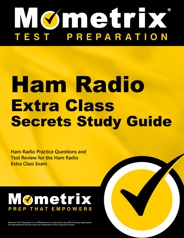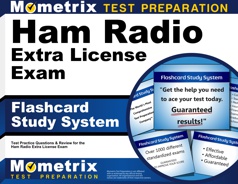The Federal Communications Commission (FCC) provides an extra class exam to certify the operation of an amateur station. This page covers the extra class radio license needed to operate an amateur radio, also called ham radio. The extra class license is intended for those who have already taken and passed the Technician Class and General Class exams.
Click “Start Test” above to take a free Ham Radio Extra Class practice test!
Exam Eligibility
To be eligible for this exam, you need a valid US mailing address, valid proof of identification, and a social security number. You must also have taken and passed the Technician Class exam and the General Class exam.
Ham Radio Extra Class Exam Outline
The Ham Radio Extra Class exam contains 50 multiple-choice questions, which are split into ten main categories.
1. Commission Rules (6 questions)
The six questions in this category are pulled from a pool of 68 questions. The pool of questions is split into six groups:
Group A
- Frequency privileges
- Signal frequency range
- Automatic message forwarding
- Stations aboard ships or aircraft
- Power restriction on 630- and 2200-meter bands
Group B
- Restrictions on station location
- General operating restrictions
- Spurious emissions
- Antenna structure restrictions
- RACES operations
Group C
- Automatic and remote control
- Band-specific regulations
- Operating in and communicating with foreign countries
- Spurious emission standards
- HF modulation index limit
- Band-specific rules
Group D
- Amateur Space and Earth stations
- Telemetry and telecommand rules
- Identification of balloon transmissions
- One-way communications
Group E
- Volunteer examiner program: definitions
- Qualifications
- Preparation and administration of exams
- Reimbursement
- Accreditation
- Question pools
- Documentation requirements
Group F
- Miscellaneous rules: external RF power amplifiers
- Prohibited communications
- Spread spectrum
- Auxiliary stations
- Canadian amateurs operating in the US
- Special temporary authority
2. Operating Procedures (5 questions)
The five questions in this category are pulled from a pool of 61 questions. The pool of questions is split into five groups:
Group A
- Amateur satellites
- Orbital mechanics
- Frequencies and modes
- Satellite hardware
- Satellite operations
Group B
- Fast-scan television standards and techniques
- Slow-scan television standards and techniques
Group C
- Contest and DX operating
- Remote operation techniques
- Log data format
- Contact confirmation
- RF network systems
Group D
- Digital modes and procedures for VHF and UHF
- APRS
- EME procedures
- Meteor scatter procedures
Group E
- Operating HF digital modes
3. Radio Wave Propagation (3 questions)
The three questions in this category are pulled from a pool of 39 questions. The pool of questions is split into three groups:
Group A
- Earth-Moon-Earth (EME) communications
- Meteor scatter
- Microwave tropospheric and scatter propagation
- Auroral propagation
- Daily variation of ionospheric propagation
- Circular polarization
Group B
- Transequatorial propagation
- Long-path propagation
- Ordinary and extraordinary waves
- Chordal hop
- Sporadic-E mechanisms
- Ground-wave propagation
Group C
- Radio horizon
- Effects of space-weather phenomena
4. Amateur Practices (5 questions)
The five questions in this category are pulled from a pool of 64 questions. The pool of questions is split into five groups:
Group A
- Analog and digital instruments
- Spectrum analyzers
- Antenna analyzers
- Oscilloscopes
- RF measurements
Group B
- Instrument accuracy and performance limitations
- Probes
- Techniques to minimize errors
- Measurement of Q
- Instrument calibration
- S parameters
- Vector network analyzers
- RF signals
Group C
- Phase noise
- Noise floor
- Image rejection
- Minimum detectable signal (MDS)
- Increasing signal-to-noise ratio and dynamic range
- Noise figure
- Reciprocal mixing
- Selectivity
- SDR nonlinearity
- Use of attenuators at low frequencies
Group D
- Dynamic range
- Intermodulation and cross-modulation interference
- Third-order intercept
- Desensitization
- Preselector
- Sensitivity
- Link margin
Group E
- External RF interference
- Electrical and computer noise
- Line noise
- DSP filtering and noise reduction
- Common-mode current
- Surge protectors
- Single point ground pane
5. Electrical Principles (4 questions)
The four questions in this category are pulled from a pool of 49 questions. The pool of questions is split into four groups:
Group A
- Characteristics of resonant circuits
- Series and parallel resonance
- Definitions and effects of Q
- Half-power bandwidth
Group B
- RL and RC time constants
- Phase angle in reactive circuits and components
- Admittance and susceptance
Group C
- Rectangular coordinates
- Polar coordinates
- Phasors
- Logarithmic axes
Group D
- Skin effect
- Real and reactive power
- Electrical length of conductors
6. Circuit Components (6 questions)
The six questions in this category are pulled from a pool of 69 questions. The pool of questions is split into six groups:
Group A
- Semiconductor materials and devices
- Semiconductor materials
- Bipolar junction transistors
- Operation and types of field-effect transistors
Group B
- Diodes
Group C
- Families of digital ICs
- Gates
- Programmable logic devices
Group D
- Permeability, core material and configuration
- Transformers
- Piezoelectric devices
Group E
- Semiconductor materials and packages for RF use
Group F
- Photoconductivity
- Photovoltaic devices
- Optical sensors and encoders
- Optically isolated switching
7. Practical Circuits (8 questions)
The eight questions in this category are pulled from a pool of 99 questions. The pool of questions is split into eight groups:
Group A
- Digital circuit principles and logic circuits
- Classes of logic elements
- Positive and negative logic
- Frequency dividers
- Truth tables
Group B
- Class of operation
- Vacuum tube and solid-state circuits
- Distortion and intermodulation
- Spurious and parasitic suppression
- Switching-type amplifiers
Group C
- Types of networks
- Types of filters
- Filter applications
- Filter characteristics
- Impedance matching
Group D
- Solar array charge controllers
- Power supplies and voltage regulators
Group E
- Detectors
- Reactance, phase, and balanced modulators
- Mixer stages
Group F
- Digital signal processing (DSP) filtering, modulation, and demodulation
- Analog-digital conversion
- Digital filters
Group G
- Characteristics and applications of operational amplifiers
Group H
- Types of oscillators
- Synthesizers and phase-locked loops
- Direct digital synthesizers
- Stabilizing thermal drift
- Microphonics
- High-accuracy oscillators
8. Signals and Emissions (4 questions)
The four questions in this category are pulled from a pool of 48 questions. The pool of questions is split into four groups:
Group A
- Fourier analysis
- RMS measurements
- Average RF power and peak envelope power (PEP)
- Analog/digital conversion</li
Group B
- Modulation methods
- Modulation index and deviation ratio
- Frequency- and time-division multiplexing
- Orthogonal frequency-division multiplexing (OFDM)
Group C
- Digital communication modes
- Information rate vs. bandwidth
- Error correction
- Constellation diagrams
Group E
- Keying defects and overmodulation of digital signals
- Digital codes
- Spread spectrum
9. Antennas and Transmission Lines (8 questions)
The eight questions in this category are pulled from a pool of 94 questions. The pool of questions is split into eight groups:
Group A
- Radiation resistance
- Gain
- Beamwidth
- Efficiency
- Effective radiated power (ERP)
- Effective isotropic radiated power (EIRP)
Group B
- Azimuth and elevation patterns
- Gain as a function of pattern
- Antenna modeling
Group C
- Practical wire antennas
- Folded dipoles
- Phased arrays
- Effects of ground near antennas
Group D
- Yagi antennas
- Parabolic reflectors
- Feed point impedance and loading of electrically short antennas
- Antenna Q
- RF grounding
Group E
- Matching antennas to feed lines
- Phasing lines
- Power dividers
Group F
- Characteristics of open and shorted feed lines
- Coax versus open wire
- Velocity factor
- Electrical length
- Coaxial cable dielectrics
- Microstrip
Group G
- The Smith chart
Group H
- Radio direction finding (RDF) techniques
- Beverage antennas
- Single- and multiple-turn loops
10. Safety (1 question)
The question in this category is pulled from a pool of 12 questions. The pool of questions cover hazardous materials, RF radiation hazards, and grounding.
Check Out Mometrix's Ham Radio Extra Class Study Guide
Get practice questions, video tutorials, and detailed study lessons
Get Your Study Guide
Registration
You can register for the exam online at the Universal Licensing System page of the Federal Communications Commission website.
How to Study
Think you aren’t a good test-taker? Maybe on a study-time crunch? Or just don’t know how to begin studying? Mometrix has designed a new Study Secrets course to help every student, no matter what study scenario you are in. Here’s what you’ll find in the Study Secrets Course:
- Techniques to Conquer Procrastination
- Steps to building a Study Plan custom to your learning style
- 7 Effective Note-Taking Methods
- Test-Taking Tips
- Memory Techniques and Mnemonics
- And much more!
Everyone learns differently, so we’ve tailored our Study Secrets Course to ensure every learner has what they need to prepare for their upcoming exam or semester. Click below to check it out!
Test Day
The Extra Class exam is offered by volunteers who work with a Volunteer Exam Coordinate under the direction of the FCC.
You will need to bring a few things with you on the day of the exam:
- A valid photo ID, such as your driver’s license or passport
- FCC Registration Number
- A check or money order to pay your registration fees
- An ink pen
- Two number-two pencils with erasers
- A calculator that has the memory erased and no formulas saved on it
Passing Score
To pass the Ham Radio Extra Class exam, you must answer 37 out of 50 questions correctly, which is a score of 74%.
You will receive your scores as soon as you finish taking the exam.
Retaking the Exam
You are allowed to retake the Extra Class exam if you did not pass the first time. You will have to pay the exam fee to retake it, but you may do so as many times as you wish. In fact, you are welcome to retake the exam on the same day as your first take.
For retakes of the exam, the large pool of questions is utilized in order to create an entirely new version of the exam each time you take it.
Check Out Mometrix's Ham Radio Extra Class Flashcards
Get complex subjects broken down into easily understandable concepts
Get Your Flashcards
FAQs
Q
How many questions are on the Ham Radio Extra Class exam?
A
There are 50 questions on the exam.
Q
How long is the Ham Radio Extra Class exam?
A
There is no set time limit, but the exam generally takes anywhere from 15 to 45 minutes.
Q
What is the passing score for the Ham Radio Extra Class exam?
A
To pass the exam, you must answer at least 74% of the questions correctly, meaning you must answer a minimum of 37 questions correctly.
Q
How much does the Ham Radio Extra Class exam cost?
A
The examination fee is $15.

